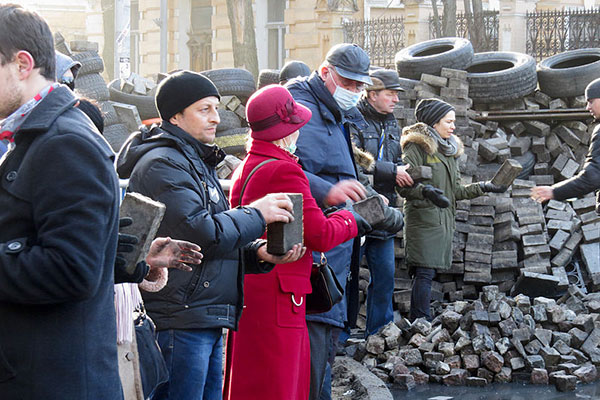The 20 Things You Need to Know to Understand What’s Happening in Ukraine

With Ukraine and Russia so much in the news, a brief historical summary of their relations seems appropriate. Ukrainians and Russians often interpret these relations differently, and even the spelling of names (e.g., Kiev or Kyiv) can be contentious. For simplicity’s sake, and with no disrespect intended toward Ukrainians, I will use the spellings traditionally used by historians of Russia. The history of Ukrainian territory is extremely complex and involves not only ethnic Ukrainians, but others such as Jewish people. The focus here, however, is on the background of Ukrainian-Russian relations.
In the late ninth century, a new East Slavic federation called Rus is formed, out of which Russians, Ukrainians, and Belorussians will eventually emerge. Scandinavian Vikings provide some of the early princes and by 900 Kiev is its capital.
1054, schism between Eastern (Orthodox) and Western Christians.
1237–1241, Mongol conquest of Rus.
By 1380, Lithuania and Poland have annexed most of the Belorussian and Ukrainian parts of old Rus. Centuries of Catholic control over these two East Slavic peoples will increasingly differentiate them from Orthodox Russians, who increasingly come under Moscow’s controls, as it gradually begins freeing itself from the “Mongol yoke” over remaining old Rus territories.
1533–1689, Russia expands westward, fighting to take over Belorussian and Ukrainian lands, and eastward into Siberia, increasing Russia’s size more than fivefold. Many wars with Polish–Lithuanian Commonwealth (PLC, officially created in 1569).
1654, by Treaty of Pereiaslavl, Ukrainian Cossacks and other Ukrainians in more than 100 towns pledge their loyalty to Russian tsar, who promises to respect traditional Ukrainian rights. Start of Thirteen Years’ War between Russia and PLC.
By 1667 treaty, PLC loses part of Ukraine, including Kiev to Russia.
1772-1795, Russia, Prussia, and Austria partition PLC (on three separate occasions) and it ceases to exist. Russia, under Catherine the Great, gained the most, a little over three-fifths of the lands of PLC. Belorussians and Ukrainians comprise about 40 percent of the population of the newly added territory. Many western Ukrainians, however (e.g., in Lvov), become part of the Austrian empire. In this same period Russia gains new territories from Turkey, including Crimea, which will eventually become part of Ukraine. Recently, at a press conference, Vladimir Putin referred to these conquests from Turkey as part of Novorossiya, an area, he said, that was not part of Ukraine in tsarist times, but “given to Ukraine in the 1920s by the Soviet government. Why? Who knows.”
1847, arrest of a small group of Ukrainian nationalists, including poet and fosterer-of-a-Ukrainian-literary-language Taras Shevchenko. Their “crime”: participating in an organization that proposed working toward the creation of a Slavic federation in which nationalities such as the Ukrainians would have their own autonomous national governments.
1863, Russian government prohibits educational, scholarly, and religious publications in Ukrainian.
1876, Russian government prohibits Ukrainian from being spoken on the stage or by teachers in the classroom, or in any new or imported publications or in school libraries.
1914-1922, World War I, Communist Revolution, Russian Civil War, and Russo-Polish War of 1920. These events provide hope and attempts by Ukrainian nationalists to create their own independent state, but in 1921 the Ukrainian Soviet Socialist Republic is established and in 1922 it becomes part of USSR. Parts of western Ukraine, e.g., Lvov, become part of the Polish state reconstituted in 1918.
1921-1923, famine in Russia and Ukraine.
1931-1933, famine in Ukraine and other parts of USSR. Millions die in Ukraine. Many Ukrainian historians refer to this as a “terror-famine,” famine-genocide, or Holodomor (a unique term emphasizing the Ukrainian mass starvation of these years) and believe it resulted almost entirely from Stalin’s agricultural collectivization policies and hostility to Ukrainians.
1939-1953, World War II to death of Stalin. USSR first gains some Ukrainian territory, including Lvov, as a result of Nazi-Soviet Pact of 1939, but after Nazi attack in 1941 Ukraine is occupied by German troops until pushed out by Soviet troops in final years of war. About 6 million Ukrainians were killed, including some 1.5 million Jews. As a result of postwar settlements, USSR gains additional western Ukrainian areas. Guerilla resistance to USSR rule in western Ukraine until mid-1950s.
1954, Soviet leader Nikita Khrushchev transfers Crimea to Ukrainian control, but since all of the USSR was then under firm Communist party direction, this transfer does not then seem that significant.
1991, collapse of Soviet Union. Ukraine and Russia become independent states.
1995, Russian-Ukrainian agreement on Crimean Black Sea fleet; Russia to be allowed to continue using the Crimean naval base at Sevastopol.
2013-2014, Ukrainian President Viktor Yanukovych backs off closer ties with European Union, but protests in Kiev lead to his ousting in Feb. 2014. Putin, long concerned with growing Western influence in former parts of the USSR, claims that West was behind driving Yanukovych from power.
March 2014, after a Crimean vote for secession, it is annexed by Russia, a step that encourages other separatists in eastern Ukraine.